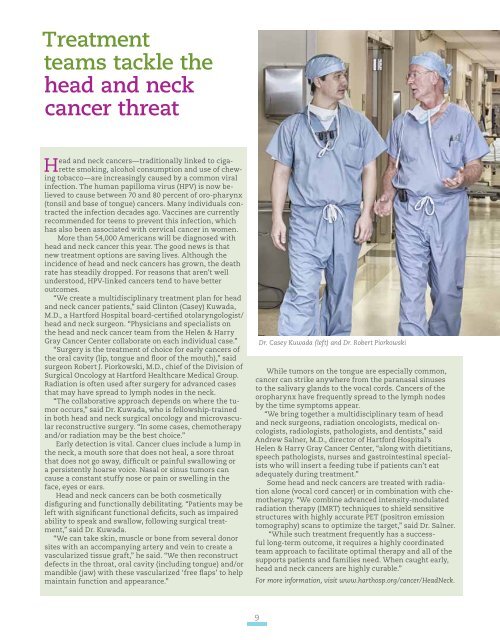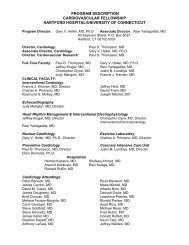Spring, 2013 - Hartford Hospital!
Spring, 2013 - Hartford Hospital!
Spring, 2013 - Hartford Hospital!
Create successful ePaper yourself
Turn your PDF publications into a flip-book with our unique Google optimized e-Paper software.
Treatment<br />
teams tackle the<br />
head and neck<br />
cancer threat<br />
Head and neck cancers—traditionally linked to cigarette<br />
smoking, alcohol consumption and use of chewing<br />
tobacco—are increasingly caused by a common viral<br />
infection. The human papilloma virus (HPV) is now believed<br />
to cause between 70 and 80 percent of oro-pharynx<br />
(tonsil and base of tongue) cancers. Many individuals contracted<br />
the infection decades ago. Vaccines are currently<br />
recommended for teens to prevent this infection, which<br />
has also been associated with cervical cancer in women.<br />
More than 54,000 Americans will be diagnosed with<br />
head and neck cancer this year. The good news is that<br />
new treatment options are saving lives. Although the<br />
incidence of head and neck cancers has grown, the death<br />
rate has steadily dropped. For reasons that aren’t well<br />
understood, HPV-linked cancers tend to have better<br />
outcomes.<br />
“We create a multidisciplinary treatment plan for head<br />
and neck cancer patients,” said Clinton (Casey) Kuwada,<br />
M.D., a <strong>Hartford</strong> <strong>Hospital</strong> board-certified otolaryngologist/<br />
head and neck surgeon. “Physicians and specialists on<br />
the head and neck cancer team from the Helen & Harry<br />
Gray Cancer Center collaborate on each individual case.”<br />
“Surgery is the treatment of choice for early cancers of<br />
the oral cavity (lip, tongue and floor of the mouth),” said<br />
surgeon Robert J. Piorkowski, M.D., chief of the Division of<br />
Surgical Oncology at <strong>Hartford</strong> Healthcare Medical Group.<br />
Radiation is often used after surgery for advanced cases<br />
that may have spread to lymph nodes in the neck.<br />
“The collaborative approach depends on where the tumor<br />
occurs,” said Dr. Kuwada, who is fellowship-trained<br />
in both head and neck surgical oncology and microvascular<br />
reconstructive surgery. “In some cases, chemotherapy<br />
and/or radiation may be the best choice.”<br />
Early detection is vital. Cancer clues include a lump in<br />
the neck, a mouth sore that does not heal, a sore throat<br />
that does not go away, difficult or painful swallowing or<br />
a persistently hoarse voice. Nasal or sinus tumors can<br />
cause a constant stuffy nose or pain or swelling in the<br />
face, eyes or ears.<br />
Head and neck cancers can be both cosmetically<br />
disfiguring and functionally debilitating. “Patients may be<br />
left with significant functional deficits, such as impaired<br />
ability to speak and swallow, following surgical treatment,”<br />
said Dr. Kuwada.<br />
“We can take skin, muscle or bone from several donor<br />
sites with an accompanying artery and vein to create a<br />
vascularized tissue graft,” he said. “We then reconstruct<br />
defects in the throat, oral cavity (including tongue) and/or<br />
mandible (jaw) with these vascularized ‘free flaps’ to help<br />
maintain function and appearance.”<br />
Dr. Casey Kuwada (left) and Dr. Robert Piorkowski<br />
While tumors on the tongue are especially common,<br />
cancer can strike anywhere from the paranasal sinuses<br />
to the salivary glands to the vocal cords. Cancers of the<br />
oropharynx have frequently spread to the lymph nodes<br />
by the time symptoms appear.<br />
“We bring together a multidisciplinary team of head<br />
and neck surgeons, radiation oncologists, medical oncologists,<br />
radiologists, pathologists, and dentists,” said<br />
Andrew Salner, M.D., director of <strong>Hartford</strong> <strong>Hospital</strong>’s<br />
Helen & Harry Gray Cancer Center, “along with dietitians,<br />
speech pathologists, nurses and gastrointestinal specialists<br />
who will insert a feeding tube if patients can’t eat<br />
adequately during treatment.”<br />
Some head and neck cancers are treated with radiation<br />
alone (vocal cord cancer) or in combination with chemotherapy.<br />
“We combine advanced intensity-modulated<br />
radiation therapy (IMRT) techniques to shield sensitive<br />
structures with highly accurate PET (positron emission<br />
tomography) scans to optimize the target,” said Dr. Salner.<br />
“While such treatment frequently has a successful<br />
long-term outcome, it requires a highly coordinated<br />
team approach to facilitate optimal therapy and all of the<br />
supports patients and families need. When caught early,<br />
head and neck cancers are highly curable.”<br />
For more information, visit www.harthosp.org/cancer/HeadNeck.<br />
9

















